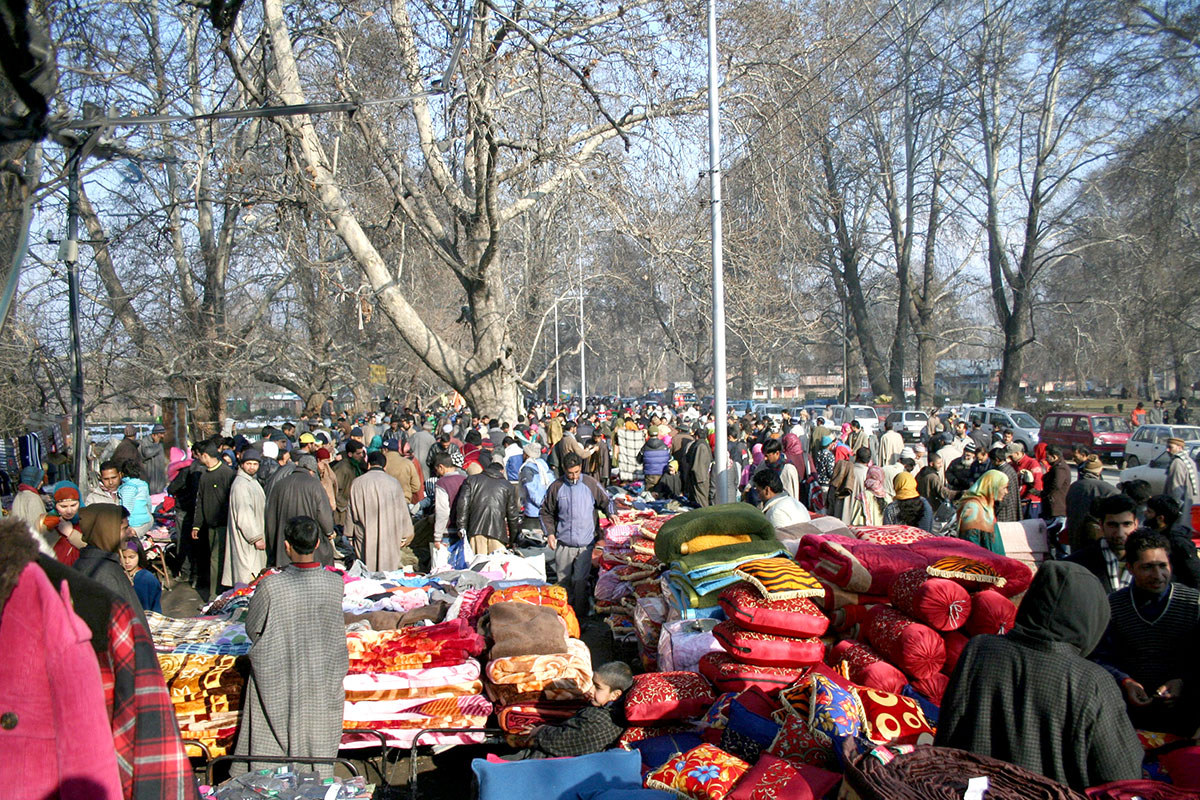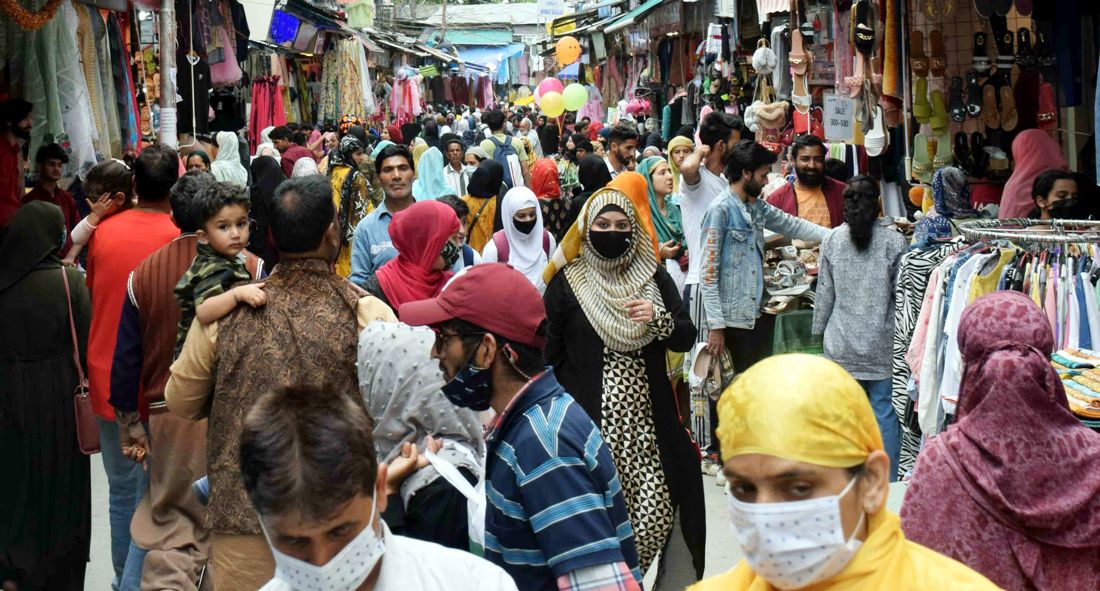While the Sunday Market continues to be the only address for comfortable and budget shopping, it is not only getting popular with tourists alone. The flea market feeds tons of material for the thriving Thrift market as well, reports Babra Wani

Despite having a middle-class upbringing, Tahir, 23, always had an eye for branded clothing, closely tracking the fashion scene. When the internet reached Kashmir in his seventh grade, it unveiled a realm of high-end brands through surfing and reading.
Residing in Sopore, Tahir’s affinity for branded clothes grew. “I developed the urge to wear those high-end brands,” he confessed. After he completed his secondary school, he opted to work in Srinagar to further delve into the world of fashion.
Curiosity drew him to the Sunday Market, Srinagar’s famed fleas market, where he discovered clothes and items from various brands. Captivated by the notion of introducing high-end brands to Srinagar, he embarked on opening his store.
“I wanted to bring these brands to my hometown, so I set up shop in the main market in Sopore,” Tahir said. “After starting the store, I was uncertain about its name, and that’s when I chose to name it after my town – Sopore Thrift.”
It swiftly attracted customers and became popular. Tahir transitioned into being his boss, earning to support his family of three, which included his sister and father.
Before launching his store, Tahir researched thrifting, ensuring he could address any queries. “Whenever people asked me if I knew what thrifting was, I had an answer because I had already read about it.”
Not alone, Tahir is just a member of a lot who have discovered both passion and profession in thrifting. The concept of ‘thrifting,’ though seemingly novel, is deeply rooted in Kashmir. In the Goni Khan area alone, over three thrift stores and vendors operate, predominantly focusing on women’s clothing. One of these establishments has thrived for three generations.
The Lal Chowk, the heart of Srinagar, boasts several more shops, with most thrifting store operators originating from Srinagar’s Shehr-e-Khas. A thrift store owner revealed his unique approach—he acquires products in Germany and other European countries, subsequently selling them in Kashmir. “I go to Germany and other European countries to buy these second-hand or ‘defective’ pieces, and then I sell them in my store,” one of the store owners said.
The people of Kashmir have actively engaged in shopping for ‘second-hand products,’ making it an integral and substantial component of the thriving thrifting culture in the region.
What is Thrifting?
Thrifting involves the purchase of second-hand clothing or items previously used and relinquished by the original buyer for any reason. This practice has gained popularity, encompassing the acquisition of pre-owned goods from thrift stores, shops, flea markets, vintage stores, sales, and similar outlets, collectively referred to as ‘thrifting.’ Extending the life cycle of products through prolonged usage aligns with sustainable living, presenting an environmentally friendly alternative to frequent fresh purchases.
Thrifting, often synonymous with second-hand marketing, has found favour, particularly in Kashmir. A ThredUp report projects the global second-hand market to reach $350 billion by 2027, affirming that it is evolving into a global phenomenon. “We have studied the second-hand market and resale industry for more than a decade,” the report reads. “It is clear that second-hand is becoming a global phenomenon that is not only changing the face of retail but ushering in a more sustainable future for fashion.”

Digital Threads Beyond Borders
In the era of fast internet in Kashmir, individuals like Tahir and many others leverage social media platforms, particularly Instagram, to promote their thrifting businesses.
Much like Tahir’s venture, 18-year-old Arqam has taken the thrifting scene to the digital platform, running an online thrift store on Instagram and boasting a dedicated website. Hailing from Lazibal, Anantnag, Arqam, is preparing for NEET, whilst operating his online store, Thrift Anantnag, for a year, being the first in the district to embark on this digital journey.
Arqam’s venture into thrifting was ignited by his love for skating. “I have been passionate about skating for some time. Observing skaters from other places, I noticed they often wear clothes with vintage vibes, a bit baggy, and stuff. That is when I began searching for similar clothing,” he explained. The breakthrough happened in Janglat Mandi, where he discovered the ideal pieces. “So, I purchased them and started sharing photos of the products, and that is how it all began.”
What began with an initial investment of Rs 500 has now burgeoned into a business fetching him over Rs 1 lakh monthly. Arqam envisions even greater success. “If I focus entirely and pay all the attention, then I can earn more than Rs 1.5 lakhs, a month.”
With the expansion of his business, Arqam now sources materials from outside Jammu and Kashmir, mainly from Ladakh and Delhi. These material consignments, arriving in kilograms, encompass a variety of wearables, from shoes to sweaters and trousers. His online shop caters to customers of all genders.
Sahil Hamid, another online thrift store owner, echoes the sentiment that the concept of online thrifting in Kashmir draws inspiration from various influences such as social media and cultural trends. “And it has gained popularity as a sustainable and budget-friendly way to shop.”
Tanzeel Ur Rehman, a Hyderpora resident, dives into the world of online thrift stores, skilfully steering his business for over two years. His inspiration mirrors the bustling Sunday Market, reminiscent of Tahir’s trajectory. “Navigating through the Sunday Market’s diverse offerings for quality brands can be a challenge,” he said. Consequently, he conceived the idea of selling these coveted products online, offering people a convenient platform for exploration and purchase.
Presently, more than 20 Instagram accounts are actively involved in the thriving thrifting business in Kashmir, evident in the hashtag #thrifkashmir amassing over 1000 posts.
The Sunday Market
Since the early 2000s, Saima, a resident of South Kashmir, has been a frequent visitor to Srinagar’s lively Sunday Market, especially during the winter months. “I visit to purchase clothing for myself and my children because my husband is a private employee, and we cannot afford to shop for brands at high-end stores,” she said.
Individuals of all ages, genders, and classes converge at the Sunday Market for their essential needs. Though its origins are unknown, the Sunday Market has evolved into one of Kashmir’s largest second-hand markets. True to its name, the market exclusively opens on Sundays, attracting people from across Kashmir, particularly during the winter season, with offerings available at highly affordable prices.
Addressing diverse needs, the market provides an array of items ranging from wearables to accessories, bags to kitchen appliances, and even stationery items. The merchandise includes both fresh items and those previously used.
Many vendors have been trading their goods in this market for more than a decade. The market secures its merchandise from various suppliers and wholesalers outside Kashmir, who then distribute these items to the Sunday Market, as well as other local shopkeepers and vendors.
Extending along the road from TRC ground to Jahangir Chowk, the market has not only retained the loyalty of local customers over the years but has also piqued the interest of non-local customers. It is now getting very popular with the visitors as well.
Breaking Stereotypes
In contrast to the traditional thrift market, the online thrift market presents a different narrative. Syeda Sakeena, a Srinagar resident, is currently pursuing her PhD in Journalism and Mass Communication. Her foray into thrifting commenced in 2018 when she posed a question on her Instagram: “How many of us practice thrifting, for various reasons?”
Passionate about the environment and a connoisseur of unique fashion, Sakeena embraced thrifting. “I don’t believe in copying; neither should anyone copy my style. Thrifting allows you to break down the monopoly of fashion, providing unique pieces to style on your own.”
Her online store, The Vintage Valley Store, stands as a pioneering venture in Kashmir. Motivated by environmental concerns, Sakeena diversified into bags in 2020. “I started my store of bags because of my great liking for them and knowledge about brands. The concept was to make both luxurious and artistic pieces available, including limited edition and hand-crafted items,” shared Sakeena.
Although faced with the initial challenge of acquainting people with the thrifting concept, she observed a positive shift. “Mine was among the firsts, and now, after three years, the scenario is changing. There are more online thrift stores available in Kashmir.”
Sakeena’s customer base extends beyond Kashmir, with a majority being non-natives. “Offline thrifting is very much in vogue in Kashmir. Out of 100 people, almost 90 have engaged in thrifting at one point or another in their lives, whether they admit it or not,” she asserted.
She explained that most of the products she sells are sourced in bulk from the mainland and offshore. “It depends on what is available in the market, and you have to be on your toes to procure these products, keeping in view the fashion and the market demand.”
Sakeena’s store primarily focuses on bags, with clothing accounting for only 10 per cent of her offerings. While some in the business are new, for others, thrifting and second-hand marketing have been longstanding traditions passed down through generations.
Generational Business
Faisal, a resident of Srinagar, has immersed himself in the thrifting business for the past five years, following in the footsteps of his father, a seasoned businessman with three decades of experience. Faisal manages his store, while his father, drawing on his wealth of expertise, operates wholesale, supplying products not only to Faisal’s store but also to the Sunday Market, street vendors, and sellers in far-flung villages.
This father-son legacy echoes in yet another duo, spanning over two decades in the thrifting trade. Specialising in ladies’ clothing such as jackets, tops, sweaters, and pants, their store, located near Goni Khan market, draws a constant crowd, particularly young girls who flock to the shop in large numbers daily.
“We provide them with all kinds of clothes from foreign brands, and the store even features a changing room for the girls to try out the clothes,” the store owner proudly shared. “Since our customers are mainly students, we have kept all of our products at affordable prices, selling jeans in the price range from Rs 200 to a maximum of Rs 500.”
(Some photographs used with this report are merely representational.)















